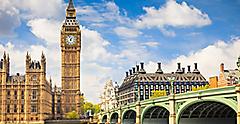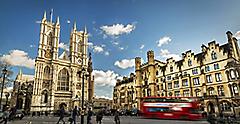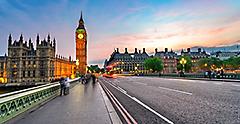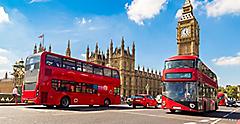By Hayley Simpson | Published on October 14, 2025
Why is it Called Big Ben
On sightseeing tours in London, a question that gets asked often is, "What is the real name of Big Ben?" Well, Big Ben's real name is Elizabeth Tower, also referred to as the Clock Tower. The nickname belongs specifically to its nearly 14-ton bell, also known as the Great Bell. It lives up to its name as the hammer inside the bell weighs over 400 pounds alone.
So, you'll technically find Big Ben inside the Elizabeth Tower. Both were built in 1859, and while the tower has undergone significant renovation recently, it's the same historic bell that chimes across the northern bank of the River Thames today. Its companions include four smaller quarter bells. For visitors seeking more facts about Big Ben, it’s worth noting that these bells together form part of the Great Clock mechanism that has become world-famous.
The origin of Big Ben's name is unknown, and there are two main theories. The first is that it was named in honor of Sir Benjamin Hall (nicknamed Big Ben), London’s first commissioner of Public Works. He was the man in charge of the construction of the Houses of Parliament. His name was inscribed on the bell when it was cast, so this is perhaps the most likely theory.
The alternative is that it was named after another Big Ben: English heavyweight boxing champion at the time, Benjamin Caunt. Indeed, many London history buffs debate whether Benjamin Caunt’s involvement was overshadowed by Sir Benjamin Hall. Nevertheless, both versions of the explanation remain part of Big Ben’s London history.
How Tall is Big Ben?
Fun Facts About Big Ben
Now that you've become acquainted, here are some fun facts about Big Ben. Firstly, since 1859, the bell has rarely stopped ringing. Even when bombs were raining down on London during World War II and destroyed the neighboring Commons Chamber, Elizabeth Tower survived, and Big Ben continued to strike every hour. During this time, the clock faces were dimmed so as not to attract attention. This resilience has cemented Big Ben’s role as an enduring emblem of London attractions.
Here are two unique scenarios when Big Ben's timekeeping wasn't at its peak accuracy. The first was when a flock of birds rested on the minute hand in 1944, slowing the clocks down. The second was on New Year's Eve in 1962, when Big Ben chimed late because snow and ice weighed down the hands. These quirky stories only add to the long list of Big Ben facts that fascinate visitors.
When it was built, the tower's clock was the world's largest and most accurate four-faced striking and chiming clock. Big Ben's timekeeping is precisely controlled by a small stack of pre-decimal penny coins placed on a huge pendulum. Adding or removing a penny changes the clock's speed by 0.4 seconds per day, so the tower expertly keeps time within a few seconds every week.
There's a special role called the Keeper of the Clock, carried about by designated personnel responsible for keeping time and hand-winding the clock three times a week. This meticulous process began back when Big Ben was built to ensure that even decades later, it remains a marvel to behold.
The Clock Tower has many special features, including 52 shields representing different historic moments. This includes the national emblems of the four nations that encompass the United Kingdom: A red and white rose for England, a thistle for Scotland, a shamrock for Northern Ireland and a leek for Wales. There's also a pomegranate for Catherine of Aragon, the first wife of Henry VIII. Such details add more layers to Big Ben’s London history, tying the tower’s decorative elements to the country’s broader narrative.
Finally, you wouldn't be out of line to refer to it as Britain’s Leaning Tower of Pisa. While its slight tilt to the northwest isn't as impressive (only 0.26 degrees), it was first discovered during the planning of the Jubilee Line extension under the Houses of Parliament. The gradual shift has intrigued structural experts, who are keen to ensure Big Ben remains stable for future generations.
Facts About the Royal Family and Big Ben’s Royal Connection
Big Ben has such a long history, it should be no surprise that many Big Ben facts overlap with facts about the royal family. These two significant parts of British history have a lot in common. Big Ben has chimed through the reigns of seven monarchs: Queen Victoria, King Edward VII, King George V, King Edward VIII, King George VI Queen Elizabeth II and King Charles III. With each reign, the Clock Tower resonated in significant royal moments, celebrating coronations or observing solemn national events. That said, how did the royal family start?
Perhaps the most fascinating British royal family fact is that the family line can be traced back more than 1,200 years. It all began with the Norman invasion in 1066. William the Conqueror landed in England, and the rest was history. Over time, key monarchs such as Queen Victoria and Queen Elizabeth II left their mark on the royal line and landmarks like Elizabeth Tower.
For nearly 500 years, the Palace of Westminster was London's principal royal residence. It began hosting the Royal Council following the Norman conquest of 1066, and in 1265, the first elected English government took up residence in its hallowed halls. Unfortunately, two fires in 1512 and 1834 destroyed the palace. It was after the latter fire that plans for the current Houses of Parliament and Elizabeth Tower took shape. Big Ben chimed for the first time on May 31, 1859, and has been ringing ever since. Anyone wanting a deep dive into Big Ben’s London construction will find that the tower’s emergence after the fire is one of the most remarkable architectural feats in the city.
In June 2012, the House of Commons announced that the clock tower housing Big Ben would be renamed Elizabeth Tower in honor of Queen Elizabeth II's Diamond Jubilee. Expanding upon a tradition of naming towers, this change reflected the enduring respect for the monarchy within the UK Parliament.
The name change mirrors a similar tribute made to Queen Victoria, the only other monarch to celebrate a Diamond Jubilee. The Houses of Parliament renamed the King’s Tower in its southwest corner the Victoria Tower in the 19th century. There's another homage to Queen Victoria (Queen Elizabeth II's great-great-grandmother) in the form of a Latin motto under a clock face (DOMINE SALVAM FAC REGINAM NOSTRAM VICTORIAM PRIMAM), which translates to "O Lord, keep safe our Queen Victoria the First." This detail highlights how interconnected the monarchy has been with Westminster Palace and its famous Clock Tower.
At the top of Elizabeth Tower, you'll find the Ayrton Light, a green lantern-like structure installed in 1885. It shines whenever either House of Parliament is in session. Named after politician Acton Smee Ayrton, Queen Victoria requested its installation to see if parliament was sitting after dark from Buckingham Palace, less than a mile away. Today, visitors who glance upward on a late session evening may spot this light, strengthening the link between the tower and royalty.
Its Roots as a British Cultural Icon
There aren't many London landmarks as culturally or historically iconic as Big Ben. This significance was recognized when it became a UNESCO World Heritage Site in 1987. It's also one of the most prominent symbols of the United Kingdom and parliamentary democracy, thanks to Big Ben’s location in London, next to the Houses of Parliament. St Stephen’s Hall, Westminster Hall and even the nearby Parliament Square add to the area’s heritage charm and remind visitors of Britain’s storied past.
Named London's most iconic film location, it's been featured in nearly 20 Disney films. This includes "Peter Pan," when Peter and the Darling siblings take a short break on one of the clock's minute hands before flying to Neverland. The BBC also first broadcast the symbolic chimes on December 31, 1923, which has since become a tradition. In fact, Big Ben's chimes echo between the main bulletins of most major U.K. news broadcasts and are heard by millions of UK residents daily.
Another feather in its cap as a British cultural icon is the fact that it's the main focus of London's annual New Year's Eve celebrations, alongside the London Eye on the opposite side of the River Thames. Every year, Big Ben's toll is joined by fireworks, light installations and live music performances. It's a symbol of unity among both residents and people around the world. If you time it right, you can stand on Westminster Bridge or near the Jubilee Gardens to witness these spectacular festivities.
Visiting Big Ben: Getting Up Close and Personal
Starting in 2017, Elizabeth Tower and Big Ben underwent the biggest conservation project in their history. After a period of suspension, public tours have recommenced and are in high demand, requiring advanced bookings (months prior) for security reasons. The 90-minute guided tours take you through the Clock Tower and the Houses of Parliament, where you see both Houses, the Royal Gallery and the Queen's Robing Room. These tours have often been called the Big Ben tour by eager visitors wanting a glimpse of the famous Big Ben Clock Tower interior.
Stand along the river banks and you’ll hear the belfry's four small quarter bells play the Westminster Quarters every quarter-hour and moments before Big Ben tolls its signature E-natural tone every hour. While in London, keep your ears peeled for Big Ben's dulcet tones, as they can be heard up to 9 miles away.
If you’re venturing to other nearby London sightseeing spots such as Kensington Palace, the Churchill War Rooms, Windsor Castle or the British Museum, consider returning to the riverbank later in the evening to listen to Big Ben ring in all its glory. An unforgettable England holiday awaits when you embark on a London-bound cruise with us.
Get Royal Deals, Sign Up Today

Getting There
Explore our British Isles cruises
Keen to learn more about how to vacation in the most memorable ways? Explore our British Isles cruises here.
Related Articles

How To Use Cruise Deck Plans
READ MORE

What Is Included On A Cruise?
READ MORE

7 Ways To Use Onboard Credit
READ MORE

How To Plan A Cruise For The First Time
READ MORE











